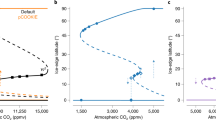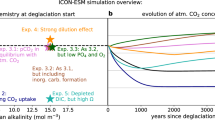Abstract
Arising from: W. R. Peltier, Y. Liu & J. W. Crowley Nature 450, 813–818 (2007)10.1038/nature06354; Peltier & Liu reply
The ‘snowball Earth’ hypothesis1 interprets geological evidence as indicating multi-million-year episodes of global glaciation near the beginning and end of the Proterozoic eon. On the basis of a coupled carbon cycle–climate model, Peltier et al.2 propose that temperature-dependent remineralization of organic carbon in a Neoproterozoic ocean with 100–1,000× more dissolved organic carbon than today3 could create a negative climate feedback, thereby preventing a snowball Earth. Their results are sensitive to initial conditions and model parameters4; moreover, important geological observations and components of the carbon cycle are not considered—notably the absence of sources or sinks of carbon. Their model results2 fall short of explaining the geological evidence in the absence of global glaciation.
Similar content being viewed by others
Main
Peltier et al.2 invoke temperature-dependent solubility of O2 as a negative climate feedback through its control on organic carbon (or dissolved organic carbon) remineralization. Temperature-dependent solubility of CO2 is ignored. With falling temperature, CO2 solubility rises more rapidly than that of O2 (ref. 5), driving a larger fraction of the total pool of dissolved inorganic carbon towards CO2(aq.), lowering CaCO3 saturation. The resulting increase in net dissolution of CaCO3 turbidites on deep-sea fans6 creates an additional sink for CO2. If CO2 solubility had been taken into account, the likely result would have been a positive rather than a negative climate feedback.
The model solutions presented2 exist only for the parameter range 0 < F21 < Fcrit (where F21 is the remineralization flux parameter and Fcrit is the critical value where the system changes behaviour from slushball to snowball cycling), implying that variations in the remineralization flux must be less than 1% for the temperature changes involved. This constraint is unlikely to be met in a system with large natural variability.
Sea-ice dynamics must have featured in Neoproterozoic low-latitude glaciation; they raise the characteristic partial pressure of CO2 at the snowball instability7. The model of Peltier et al.2 lacks sea-ice dynamics but assumes that isotopic fractionation associated with organic carbon fixation has a strong dependence on the partial pressure of CO2 (ref. 2). This dependence is highly nonlinear8 and might well be negligible if sea-ice dynamics were included.
The modelled isotopic fluctuations2 accompanying the slushball-interglacial cycle are compared with isotopic data9 from Neoproterozoic strata. This comparison is likely to be inappropriate because the isotopic fluctuations occur mostly on shallow-water marine carbonate platforms where no deposition occurred during glacioeustatic lowerings.
The palaeogeography used in the model2 is contrary to what has long been inferred from sedimentological and palaeomagnetic observations (see refs 10, 11 for a summary). In the model2, a supercontinent is situated over the South Pole. This would produce a relatively warm climate if CO2 sources and sinks were included, because low average terrestrial temperatures and moisture would reduce weathering rates, maintaining higher CO2 levels. Conversely, palaeomagnetically informed geographies10,11 with fragmented equatorial continents produce cold climates12, as are observed.
Peltier et al.2 remark that their point of departure was criticism13 that a slushball glaciation would not be stable for millions of years, as inferred geologically14. The criticism13 was that “with all the continents covered in ice, volcanic emissions without chemical weathering would cause atmospheric CO2 levels to rise. But with ice-free tropical oceans, even a modest rise in CO2 would cause the tropical glaciation to be short-lived”. Consistent with this claim, it was later shown that the CO2 required to deglaciate a slushball was ∼100× less than for a snowball15, implying that its duration should be <1% the length of a snowball glaciation. As the carbon cycle model in the present work2 has no sources or sinks of carbon, the criticism13 was never addressed.
The existence of sub-glacial and ice-proximal deposits at sea level close to the palaeoequator, and in carbonate-dominated successions formed in the warmest parts of the surface ocean, provide compelling evidence for two pan-glacial episodes in Cryogenian time. The extent of ice cover on the oceans is indeterminate because of sea-floor subduction and because evidence of open water on glaciated margins is equivocal—deposits could represent initial ice advance or terminal retreat, not maximum extent. However, an ice-covered ocean better explains the duration of the pan-glacial periods14, uniquely associated Fe2O3 and MnO2 ore deposits1, and syn-deglacial cap dolostones at all palaeolatitudes6.
References
Kirschvink, J. L. in The Proterozoic Biosphere (eds Schopf, J. W. & Klein, C.) 51–52 (Cambridge Univ. Press, 1992)
Peltier, W. R., Liu, Y. & Crowley, J. W. Snowball Earth prevention by dissolved organic carbon remineralization. Nature 450, 813–818 (2007)
Rothman, D. H., Hayes, J. H. & Summons, R. E. Dynamics of the Neoproterozoic carbon cycle. Proc. Natl Acad. Sci. USA 100, 8124–8129 (2003)
Crowley, J. W. Carbon Cycle Dynamics for a Neoproterozoic Climate Model. B.Sc. thesis, Univ. Toronto (2006); available at 〈http://www.snowballearth.org〉
Murray, C. N. & Riley, J. P. The solubility of gases in distilled water and sea water — IV. Carbon dioxide. Deep-Sea Res. 18, 533–541 (1971)
Hoffman, P. F. et al. Are basal Ediacaran (635 Ma) “cap dolostones” diachronous? Earth Planet. Sci. Lett. 258, 114–131 (2007)
Lewis, J. P., Weaver, A. J. & Eby, M. Snowball versus slushball Earth: Dynamic versus nondynamic sea ice? J. Geophys. Res. 112, C11014 (2007)
Kump, L. R. & Arthur, M. A. Interpreting carbon-isotope excursions: Carbonates and organic matter. Chem. Geol. 161, 181–198 (1999)
Hayes, J. M., Strauss, H. & Kaufman, A. J. The abundance of 13C in marine organic matter and isotopic fractionation in the global biogeochemical cycle of carbon during the past 800 Ma. Chem. Geol. 161, 103–125 (1999)
Trindade, R. I. F. & Macouin, M. Paleolatitude of glacial deposits and paleogeography of Neoproterozoic ice ages. C.R. Geosci. 339, 200–211 (2007)
Li, Z. X. et al. Assembly, configuration, and break-up history of Rodinia: A synthesis. Precambr. Res. 160, 179–210 (2008)
Donnadieu, Y., Goddéris, Y., Ramstein, G., Nédélec, A. & Meert, J. A 'snowball Earth' climate triggered by continental break-up through changes in runoff. Nature 428, 303–306 (2004)
Schrag, D. P. & Hoffman, P. F. Life, geology and snowball Earth. Nature 409, 306 (2001)
Hoffman, P. F., Kaufman, J. A. & Halverson, G. P. Comings and goings of global glaciations on a Neoproterozoic carbonate platform in Namibia. GSA Today 8, 1–9 (1998)
Crowley, T. J., Hyde, W. T. & Peltier, W. R. CO2 levels required for deglaciation of a “near-snowball” Earth. Geophys. Res. Lett. 28, 283–286 (2001)
Author information
Authors and Affiliations
Rights and permissions
About this article
Cite this article
Hoffman, P., Crowley, J., Johnston, D. et al. Snowball prevention questioned. Nature 456, E7 (2008). https://doi.org/10.1038/nature07655
Received:
Accepted:
Issue Date:
DOI: https://doi.org/10.1038/nature07655
This article is cited by
-
A Review of the Neoproterozoic Global Glaciations and a Biotic Cause of Them
Earth Systems and Environment (2021)
-
The transition from the present-day climate to a modern Snowball Earth
Climate Dynamics (2010)
-
Peltier & Liu reply
Nature (2008)
Comments
By submitting a comment you agree to abide by our Terms and Community Guidelines. If you find something abusive or that does not comply with our terms or guidelines please flag it as inappropriate.



